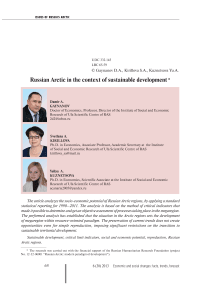Russian arctic in the context of sustainable development
Автор: Gaynanov Damir Akhnafovich, Kirillova Svetlana Aleksandrovna, Kuznetsova Yuliya Aleksandrovna
Журнал: Economic and Social Changes: Facts, Trends, Forecast @volnc-esc-en
Рубрика: Issues of Russia'S arctic
Статья в выпуске: 6 (30) т.6, 2013 года.
Бесплатный доступ
The article analyzes the socio-economic potential of Russian Arctic regions, by applying a standard statistical reporting for 1990-2011. The analysis is based on the method of critical indicators that made it possible to determine and get an objective assessment of processes taking place in the megaregion. The performed analysis has established that the situation in the Arctic regions sets the development of megaregion within resource-oriented paradigm. The preservation of current trends does not create opportunities even for simple reproduction, imposing significant restrictions on the transition to sustainable territorial development.
Sustainable development, critical limit indicators, social and economic potential, reproduction, russian arctic regions
Короткий адрес: https://sciup.org/147223543
IDR: 147223543 | УДК: 332.145
Текст научной статьи Russian arctic in the context of sustainable development
The article analyzes the socio-economic potential of Russian Arctic regions, by applying a standard statistical reporting for 1990–2011. The analysis is based on the method of critical indicators that made it possible to determine and get an objective assessment of processes taking place in the megaregion. The performed analysis has established that the situation in the Arctic regions sets the development of megaregion within resource-oriented paradigm. The preservation of current trends does not create opportunities even for simple reproduction, imposing significant restrictions on the transition to sustainable territorial development.
Sustainable development, critical limit indicators, social and economic potential, reproduction, Russian Arctic regions.
The unique potential of the Russian Arctic, which is formed by rich natural resources and geographical location, provides the possibility of sustainable development not only for the Arctic territories, but for the country as a whole. Nevertheless, all country-specific characteristics of the current stage of economic development are inherent in the Arctic regions, as well as in other subjects of the Russian Federation. The processes of late years, in particular the strengthening of globalization and regionalization, Russia’s accession to the WTO, change in the relations between the centre and regions result in the restrictions of economic, social and environmental activities, substantially narrowing the possibilities of the macro-region to move towards sustainable development. The assessment of these possibilities causes the need for a detailed analysis of the compliance of the Arctic regions development with the imperatives of sustainable development, in particular its balance, safety and efficiency in achieving stated social, ecological and economic objectives and priorities, determining the viability of a regional system [6].
The latter implies, first of all, compliance assessment of the requirements for the development of the region’s basic (economic, social and environmental) subsystems on a parity basis, and secondly, the comparison of the resulting parameters of the subsystems development with certain thresholds, determining how safe it is.
When it comes to fulfilling the first requirement, the following is obvious: the unconditional priority of the development of the economic sphere of Russian regions at the expense of the social and environmental subsystems of social reproduction does not allow considering this development balanced. As for the second imperative it should be noted that critical limit (threshold) indicators1 that have been successfully applied in various fields of science and technology can be regarded as a security threshold, within which the impact on regions does not seriously hamper their development.
Dynamics of the social potential of Russian Arctic regions in terms of safe development
The modification of prime imperative from the environmental to socio-economic one, when determining the content of sustainable development, requires analyzing the set of factors facilitating and constraining the potential of the Arctic regions, primarily in the context of social and economic components.
It needs no elaboration to state that it is the man, who is the most important object of development; it is living standards that determine the level of the region’s development, the resulting parameters of which determine the efficiency of economic performance, effectiveness of the adopted management decisions, and eventually conditioning the sustainability of regional development. The increase in the quantitative parameters of economic growth is not considered as an end in itself, but, particularly, as an opportunity to implement effective socially-oriented policy.
Thus, the comparison of the reproductive parameters of the Arctic human potential with critical limit values (hereinafter, CLV) [1, p. 590] suggests that in the last 20 years all regions of the Arctic zone, as well as the whole Russia, have been far beyond critical limits by the key indicators, characterizing demographic situation in the regions (birth and death rates) ( tab. 1,2 ).
The situation in the sphere of demographic reproduction is exacerbated by negative migration balance in all regions of the Arctic zone, except for the Yamalo-Nenets AO, where, on the contrary, an intensive population influx has been observed during the last decade (peak in 2011). Particularly intensive population outflow was observed in the Chukotka AO, with the peak of 70.4 people per mille of population in 2000.
Table 1. Birth rate value in the Arctic regions in 1990, 2000 and 2011, per mille (CLV=22 per mille) [3, p. 48; 4, p. 56; 5, p. 74]
|
Region |
Birth rate value |
Ratio of the actual value (for 2011) to the critical limit value, times |
||
|
1990 |
2000 |
2011 |
||
|
Russian Federation |
13.4 |
8.7 |
12.6 |
1.75 times less |
|
Arkhangelsk Oblast |
13.5 |
8.8 |
12.2 |
1.80 times less |
|
including Nenets AO |
16.7 |
13.2 |
15.2 |
1.45 times less |
|
Murmansk Oblast |
11.5 |
8.6 |
11.5 |
1.91 times less |
|
Yamalo-Nenets AO |
16.3 |
11.7 |
15.6 |
1.41 times less |
|
Krasnoyarsk Krai |
14.3 |
9.3 |
13.5 |
1.63 times less |
|
Sakha Republic (Yakutia) |
19.6 |
13.7 |
17.1 |
1.29 times less |
|
Chukotka AO |
14.3 |
11.5 |
13.6 |
1.62 times less |
Table 2. Death rate value in the Arctic regions in 1990, 2000 and 2011, per mille (CLV=12.5 per mille) [3, p. 50; 4, p. 58; 5, p. 76]
|
Region |
Death rate value |
Ratio of the actual value (for 2011) to the critical limit value, times |
||
|
1990 |
2000 |
2011 |
||
|
Russian Federation |
11.2 |
15.3 |
13.5 |
1.08 times higher |
|
Arkhangelsk Oblast |
9.8 |
16.3 |
13.9 |
1.11 times higher |
|
Nenets AO |
7.0 |
12.9 |
10.5 |
1.19 times less |
|
Murmansk Oblast |
6.0 |
11.6 |
11.5 |
1.09 times less |
|
Yamalo-Nenets AO |
3.3 |
5.6 |
5.4 |
2.31 times less |
|
Krasnoyarsk Krai |
9.6 |
14.8 |
13.0 |
1.04 times higher |
|
Sakha Republic (Yakutia) |
6.8 |
9.7 |
9.4 |
1.33 times less |
|
Chukotka AO |
3.9 |
9.6 |
11.1 |
1.13 times less |
As a result of these trends reflecting the development of territories under the conditions of narrowed productivity, not compensated by mechanical inflow, the level of natural population increase is far below the critical value ( fig. 1 ).
The analysis of the presented data indicates that in the last 20 years the negative trend of population decline has remained in the regions of the Russian Arctic, as well as in the whole Russia, characterized, though, by not so supercritical threshold exceeding. The exception is the Arkhangelsk Oblast with one of the lowest birth rates in the megaregion (13.5; 8.8 and 12.2 per mille in 1990, 2000 and 2011, respectively) and the highest mortality rate (9.8; 16.3 and 13.9 per mille, respectively).
As a consequence, the share of the megaregion’s population in the country decreased considerably since the beginning of market reforms. In 2011, 6.38 million people populated its vast territory (4.46% of Russian population), which is less by 699.3 thousand people than in 2000, and by 1271 thousand than in 1990, the population density here is 10 times lower than the Russian average (0.83 people/square kilometer as against 8.36 people/square kilometer, respectively). In the period since 1990, the population number increased only in the Yamalo-Nenets AO. The most considerable in absolute terms population decline was recorded in the Murmansk Oblast and Krasnoyarsk Krai (401.0 and 325.0 thousand people, respectively).The percentage ratio of the Chukotka AO suffered most with more than 2-fold population decrease over the same period (by 67.7%).
Figure 1. Natural population increase in Russian Arctic regions in 1990, 2000, 2011, per mille [3, p. 46; 4, p. 62; 5, p. 68]
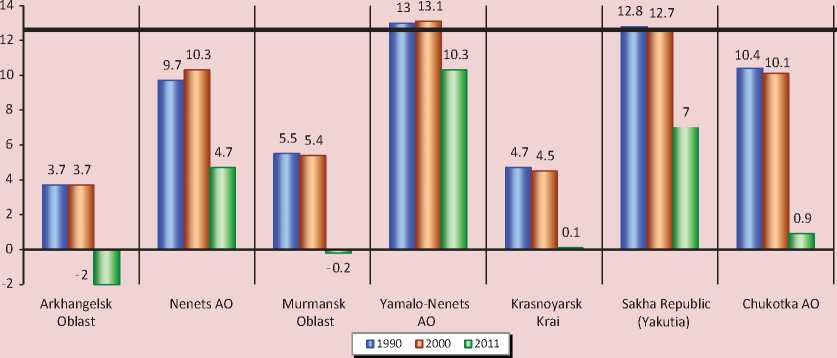
Note. Hereinafter, the solid line in the figure shows the level of critical limit value.
High living costs, unfavourable weather conditions, insufficient coverage and considerable spatial differentiation of social infrastructure determine the value of the indicator of life expectancy in the Arctic below the average Russian rate. The exception is the Yamalo-Nenets AO, where steady increase of the average Russian level is associated with high outflow of older people to the territories with more favorable weather conditions – the so-called “morbidity export”, typical of the regions with the resource-based economic orientation ( fig. 2 ).
The lowest life expectancy in the group of the Arctic regions for the last decade is observed in the Chukotka AO (64,72 years old in 1992). It is partly connected with the high share of low-numbered peoples of the North among the okrug’s rural population, as specific and rather expensive socio-economic policy is required, in order to support them.
On the whole, the given indicator is noted to have recovered up to the 1990 level, after “the collapse” of 2000s. The change in the life expectancy trend from decrease to increase is significant for the social development of regions, yet it is too early to say whether at least, the critical limit value will be achieved.
The situation in the labour market relies heavily on the economic state and ongoing territorial demographic and migration processes. As follows from the analysis, the unemployment level in the regions of the Arctic zone is in agreement with all-Russian tendencies, in particular its significant decrease in the 2000–2011 period, approximately to the 1992 level – from the maximum (13.4%) in the Murmansk Oblast to 3.7% in the Yamalo-Nenets AO (in the Russian Federation – from 10.6% in 2000 to 6.6% in 2011). The comparison with critical limit value (5%) indicates that throughout practically the whole period under review, the unemployment rate was below critical only in the Chukotka AO and over the last years in the Yamalo-Nenets AO ( fig. 3 ).
The maximum values of the unemployment rate are registered in the Murmansk Oblast, the Yamalo-Nenets AO and Krasnoyarsk Krai. The presence of these maximums is caused by the
Figure 2. Population life expectancy in Russian Arctic regions in 1990, 2000, 2011, years [3, p. 56; 4, p. 64; 5, p. 84]
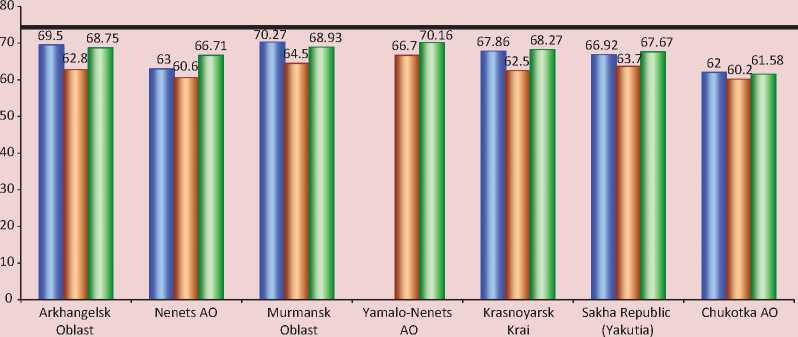
□ 1990 □ 2000 □ 2011
Figure 3. The unemployment level in the Russian Arctic regions, according to the ILO methodology, in 1994, 2000 and 2011, % [3, p. 89; 4, p. 115; 5, p. 120]
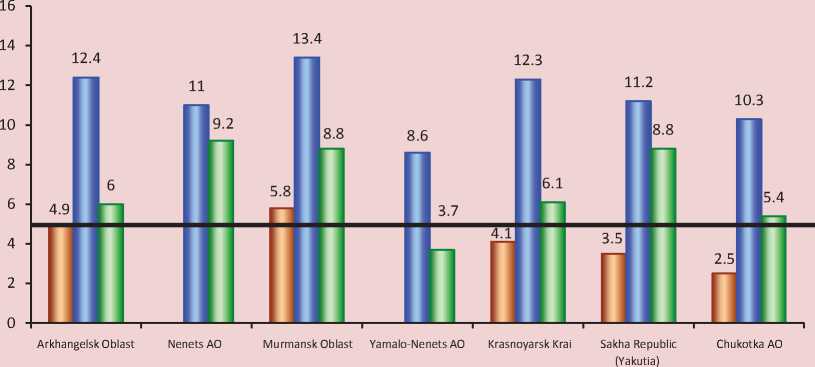
□ 1994 □ 2000 □ 2011
negative influence of both global and Russian trends of economic development, expressed in the decline in mining operations and in the volumes of manufacturing activities, change in prices for certain types of raw materials that had been previously in demand in the world market, as well as the specific character of the age and quality (professional) structure of redundant employees (high share of youth, education workers, enterprises of the military-industrial complex).
Per capita income is an important indicator of population living standards, the level of which in the Arctic regions is above the Russian average (the regions of the Arctic group hold top positions in the Russian rating2). The exception is the Krasnoyarsk Krai with the population income being slightly lower than the Russian average only in 2010 and 2011 (18262 and 20145 rubles per person per month, respectively). It should be noted that the Nenets AO has been leading by this indicator since 2007, leaving Moscow behind (54632 rubles per person per month to 20755 rubles per person, respectively, in 2011). This situation is largely due to the availability of large-scale raw hydrocarbon deposits with high exploration degree of oil and gas areas, rather close-together arrangement and proximity to European markets in the okrug’s territory [7]. The depletion level of developed oil reserves in the area does not exceed 10%, and of free gas is less than 1% [2].
High level of average per capita income, however, is not seen as a guarantee of social equity. The indicator “share of population with income below minimum subsistence level” in all regions, except for the Yamalo-Nenets, Nenets and Chukotka autonomous okrugs, is far beyond critical limit value (7%), despite notable reduction in the level of social inequality in the period since 1994 ( tab. 4 ).
In comparison with 1994, much less 2000, the share of population with income below minimum subsistence level decreased in all Arctic regions, except for Krasnoyarsk Krai. The maximum decrease of the indicator value was registered in the Chukotka AO, from 50.1% in 2000 to 9% in 2011.
The largest social stratification across the macroregion is registered in the Nenets and Yamalo-Nenets autonomous okrugs, Krasnoyarsk Krai, where the R/P 10% ratio is invariably higher than in Russia on average.
Having reached the maximum marks in the crisis year of 2008 for the 2002–2010 period, the degree of social stratification in these regions decreased by 2011 and amounted to 19.3%; 17.1% and 17.3%, respectively, with the Russian average of 16.2%. In other regions, the ratio between the average levels of income of decile population groups and the highest and lowest income does not exceed the average Russian level. Social stratification processes, which are characterized by the Gini coefficient, steadily rising and exceeding critical limit (0.3) throughout the period reviewed, also indicate the existence of negative trends, common for both the Arctic regions and for the country as a whole ( fig. 4 ).
Thus, the analysis of trends, existing in the social subsystem of the megaregion in the last 20 years, shows the degradation of the megaregion’s social potential that does not meet current requirements concerning the development mainly by means of human capital and its quality. The analysis also indicates the presence of significant development restrictions, confirming the appropriateness of the conclusion made by S.Yu. Glazyev, and V.V. Lokosov that the ongoing trends deprive Russian society of the opportunity of even simple reproduction, say nothing of the possibility of the transition to sustainable development [1, p. 591].
Development of the economic potential of the Arctic megaregion
The lucrative resource potential of the Arctic is one of the factors, determining the volumetrics of its social potential. However, the development of the macro-region, carried out within the framework of resource-oriented paradigm, results in high dependence of certain types of raw materials on demand and price characteristics of the world markets. Thus, the fall in world prices for tin and tungsten in the 1990s caused the termination of its production in the Chukotka AO. This determines the
Table 4. Share of population with income below minimum subsistence level in the regions of the Russian Arctic in 1994, 2000, 2011, as a percentage of the subject’s total population (CLV=7.0%) [3, p. 116; 4, p. 148; 5, p. 190]
|
Region |
Indicator |
Ratio of the actual value (for 2011) to the critical limit value, times |
||
|
1994 |
2000 |
2011 |
||
|
Russian Federation |
22.4 |
29.0 |
12.1 |
1.73 times higher |
|
Arkhangelsk Oblast |
20.8 |
33.5 |
14.4 |
2.06 times higher |
|
including Nenets AO |
- |
37.9 |
7.7 |
1.10 times higher |
|
Murmansk Oblast |
19.1 |
24.9 |
13.6 |
1.94 times higher |
|
Yamalo-Nenets AO |
- |
11.1 |
7.5 |
1.07 times higher |
|
Krasnoyarsk Krai |
18.3 |
24.4 |
18.1 |
2.59 times higher |
|
Sakha Republic (Yakutia) |
22.7 |
28.3 |
18.6 |
2.66 times higher |
|
Chukotka AO |
18.2 |
50.1 |
9.0 |
1.29 times higher |
Figure 4. Gini coefficient in the regions of the Russian Arctic in 2002*, 2011 [4, p. 128; 5, p. 162]
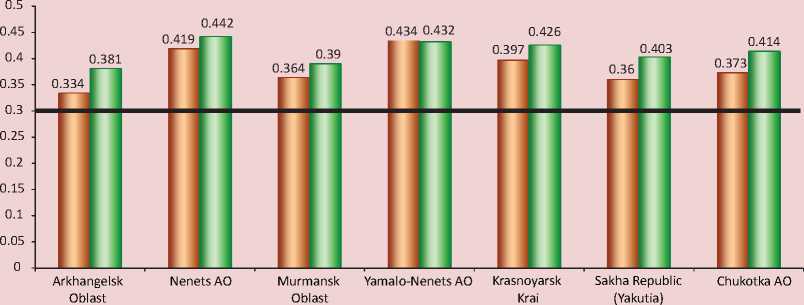
□ 2002 □ 2011
efficiency of extracting strategic kinds of resources and their primary processing, hence, the competitive ability of the industrial sector of the Russian Arctic.
In this regard, significant demand for hydrocarbons affected, above all, the level and rates of investments in the fixed capital of the Arctic regions. The investment volumes, far exceeding critical limit, and stably high in comparison with GRP, have been observed in the Yamalo-Nenets AO during the whole period under review, in the Nenets AO up to 2008, in the Chukotka AO in the period of oil and gas industry development (2000s). In the Sakha Republic (Yakutia), the implementation of major investment projects, particularly in transportion infrastructure and fuel and energy complex in 2005–2011 allowed maintaining high level of investment activity, aimed at the significant improvement of the competitiveness of these spheres. While in 1994 the specific volume of investments in fixed capital exceeded the average Russian values only in one Arctic region – the Sakha Republic (Yakutia), by 2011 the indices above the average national level (23.81%) were registered in three regions of the Arctic, and were above the critical limits (tab. 5).
Relatively high volume of the investments in fixed capital of Russian Arctic regions, however, does not provide for the diversification of the regional economy, significant progressive structural changes and adequate growth of production and technological potential. In particular, the reason for this is high degree of fixed capital depreciation that either exceeds the critical limit or is near it, though the degree of fixed capital depreciation in the megaregion as a whole, except for the Yamalo-Nenets AO (1.42 times above critical values) is not higher than the national average ( tab. 6 ).
High degree of fixed capital depreciation, indicating that modern industrial technologies are not implemented, not only reduces the sustainability of production systems and increases the threat of technogenic and ecological disasters, but also decreases the industrial and technological potential and competitive ability of industrial facilities, as well as the territories, in which they are located.
The widespread degradation of the industrial structure, characterized by the decline in the share of manufacturing industries, indicates the decrease of the production and technological potential and high-tech industry stagnation ( tab. 7 ).
Significant lagging of the Russian Arctic economy behind the world economy indicates the insufficient level of the applied technologies, production output with small share of added
Table 5. Volume of investments in fixed capital, as a percentage to GDP (CLV=25%) [3, p. 726; 4, p. 834; 5, p. 928]
|
Region |
Indicator |
Ratio of the actual value (for 2011) to the critical limit value, times |
||
|
1994 |
2000 |
2011 |
||
|
Russian Federation |
17.82 |
20.25 |
23.81 |
1.05 times less |
|
Arkhangelsk Oblast |
13.05 |
16.94 |
30.25 |
1.21 times higher |
|
including Nenets AO |
- |
22.32 |
16.58 |
1.51 times less |
|
Murmansk Oblast |
15.18 |
13.04 |
23.80 |
1.05 times less |
|
Yamalo-Nenets AO |
- |
70.24 |
60.47 |
2.42 times higher |
|
Krasnoyarsk Krai |
15.25 |
11.86 |
13.55 |
1.85 times less |
|
Sakha Republic (Yakutia) |
21.79 |
19.29 |
32.43 |
1.30 times higher |
|
Chukotka AO |
14.29 |
17.83 |
4.28 |
5.84 times less |
Table 6. Fixed capital depreciation, % (CLV=40%) [3, p. 279; 4, p. 341; 5, p. 419]
|
Region |
Indicator |
Ratio of the actual value (for 2011) to the critical limit value, times |
||
|
1996 |
2000 |
2011 |
||
|
Russian Federation |
40.5 |
43.5 |
46.3 |
1.16 times higher |
|
Arkhangelsk Oblast |
43.4 |
51.1 |
38.4 |
1.04 times less |
|
including Nenets AO |
29.4 |
39.8 |
31.1 |
1.29 times less |
|
Murmansk Oblast |
40.2 |
41.8 |
42.8 |
1.07 times higher |
|
Yamalo-Nenets AO |
35.3 |
33.7 |
56.9 |
1.42 times higher |
|
Krasnoyarsk Krai |
35.7 |
37.3 |
38.4 |
1.04 times less |
|
Sakha Republic (Yakutia) |
31.0 |
38.9 |
40.1 |
1.003 times higher |
|
Chukotka AO |
39.3 |
31.7 |
40.8 |
1.02 times higher |
Table 7. Share of manufacturing in the industry, % (CLV=70%) [3, p. 328-332; 4, p. 414-418; 5, p. 466, 472]
|
Region |
Indicator |
Ratio of the actual value (for 2011) to the critical limit value, times |
||
|
1997 |
2001 |
2011 |
||
|
Russian Federation |
43.1 |
69.1 |
73.8 |
1.05 times higher |
|
Arkhangelsk Oblast |
17.6 |
77.2 |
33.21 |
2.11 times less |
|
including Nenets AO |
0.6 |
3.0 |
0.49 |
142.86 times less |
|
Murmansk Oblast |
67.0 |
81.8 |
39.92 |
1.75 times less |
|
Yamalo-Nenets AO |
0.6 |
2.1 |
12.14 |
5.77 times less |
|
Krasnoyarsk Krai |
64.8 |
90.1 |
63.43 |
1.10 times less |
|
Sakha Republic (Yakutia) |
55.2 |
79.3 |
7.85 |
8.92 times less |
|
Chukotka AO |
41.8 |
68.1 |
1.66 |
42.17 times less |
Table 8. Share of innovations, as a percentage of GRP (CLV=4.2%) [3, p. 690; 4, p. 768; 5, p. 814]
The current situation, fixating export-and raw materials-oriented direction of the development of the Arctic megaregion, imposes significant restrictions on the economic and social development of the territories with no primary resources that are in high demand in the world market. Moreover, the vulnerability of the megaregion’s economy to the price parameters of the world energy market has been increasing. Price fluctuations in the medium and long-term perspective are rather predictable.
Lucrative natural resources of the Arctic provide unique opportunities for the formation of policy oriented to the transition to sustainable development, hence, to promoting economic and social potential. The economic growth should be ensured not so much by extractive industries and the increase in the export deliveries of raw materials, but by improving quality of human capital and its effective use.
Список литературы Russian arctic in the context of sustainable development
- Glazyev S.Yu., Lokosov V.V. Estimation of the indicators at the critical limit of the Russian society and their use in the management of the socio-economic development. Herald of the Russian Academy of Sciences. 2012. V. 82. No.7. P. 587-614.
- Official web-site of the Nenets AO administration. Available at: http://www.adm-nao.ru/?show=statics&id=39
- Russian regions. Socio-economic indicators. 1998: statistical digest/State Statistics Committee of the Russian Federation. Мoscow, 1998.
- Russian regions. Socio-economic indicators. 2003: statistical digest/State Statistics Committee of the Russian Federation. Мoscow, 2003.
- Russian regions. Socio-economic indicators. 2011: statistical digest/Rosstat. Мoscow, 2011.
- Tsapieva O. K. Sustainable development of regions: theoretical foundations and the model. Problems of modern economics. 2010. No.2(34). P. 46-49.
- Yushkin N.P. The Arctic region in the strategy of fuel and energy prospects implementation. Ed. by V.Ye. Fortov, Yu.G. Leonova. Мoscow: Nauka, 2006.

